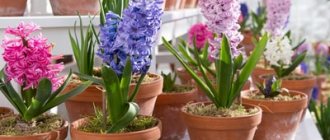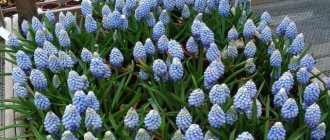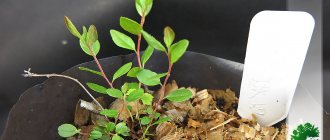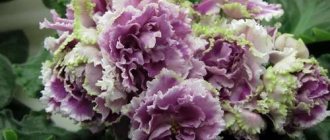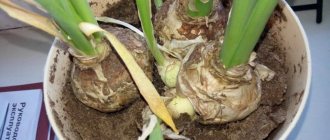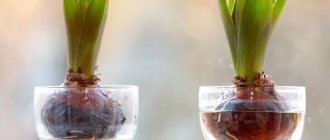A unique feature of this plant is that it floats on the surface of bodies of water (lakes, ponds, swamps). Water hyacinth came to us from South America. Grows successfully in all places with a tropical climate .
Hyacinth resembles a flower only in appearance; this plant lives only on water. In nature it grows quite quickly, entwining the water surface like a skillfully woven carpet.
Description of the plant
Another name is eichornia. Refers to annuals. The shoots are very tall (up to 2 meters), the leaves are rosette-type with compacted bases. They are porous inside . Thanks to this, the plant floats freely on water.
The roots are quite powerful, up to half a meter in length. They are not visible on the surface; they are completely hidden under the water column. Eichornia flowers are large, delicate, consisting of 6 petals, predominantly amethyst in color with a blue tint.
Characteristics
The flower got its name due to its resemblance to the ornamental plant hyacinth. However, the relationship between them has not been established, therefore Eichornia is considered a typically aquatic plant, the favorable environment for which is warm waters.
In nature, this plant blooms for many years. Its cuttings act as a kind of floats supporting a rather large rosette. If it blooms alone, then the swellings located on the cuttings are spherical in shape and large in size. If the plants form huge colonies, then these swellings become much smaller. Moreover, in the process of root formation they disappear altogether due to their uselessness.
Eichornia species
This plant blooms all summer long. But each bud pleases with its appearance for only forty-eight hours , after which the peduncle goes under water. Eichornia blooms especially brightly and abundantly in hot and rainy weather.
If a large number of hyacinths grow in a pond, during the budding period it turns into a bright carpet of incredibly beautiful shades .
The most popular types for aquariums and park ponds:
- Azure (on the picture). Leaves growing underwater have the shape of narrow pale green ribbons. The above-water part of the plant is characterized by bright oval leaves. Their surface has a ribbed structure. Designed for growing in an aquarium. Conditions are as close to tropical as possible.
- Variegated. It grows exclusively under water. Elongated leaves alternate with each other in different shades of green (from juicy emerald to light green). This is a plant requires less attention, reproduces well. Suitable for aquariums of different sizes.
- Centipede. It has glossy leaves of rich green color. The petioles are compacted. Flowers appear towards the end of summer and look very impressive. They are predominantly amethyst in color. On one of the six petals there is a spot in the shape of the card suit of spades indigo color with lemon flecks. Unfortunately, it is almost impossible to see such beauty at home. This species does not tolerate low thermometer readings.
Propagation of water hyacinth
Eichornia reproduces vegetatively . In an adult specimen, shoots form on the side shoots, which are separated from the main plant after the formation of 3-4 young leaves on them. Gardeners should pay attention to the fact that eichornia shoots should be handled with care, since the juice of this plant contains a number of alkaloids that can cause a skin reaction in the form of itching and irritation.
In its natural environment, the plant can reproduce by seeds. However, in a home aquarium it is difficult to obtain seed material. This requires temperatures above 35°C. Similar conditions can be created in special greenhouses. At home, a similar effect can be achieved with additional heating.
Features of planting and growing
This amazing plant can be cultivated both at home and outdoors . Planting and caring for it are easy. It is enough to create the right conditions for it so that the flower regularly delights with its beauty.
In the pond
First of all, you need to choose the right reservoir : shallow, in an open area, without drafts. Eichornia needs a lot of warmth and light. Before planting, the soil is fertilized with humus, compost or mullein. Sludge from the bottom (only purified) and complex fertilizer are also suitable. These substances are used for a feeding cycle throughout the year .
You need to wait for stable warm weather so that the water column warms up enough (at least to 25 - 30 degrees). A sharp contrast between day and night temperatures is undesirable. If the summer is cool, you shouldn’t expect flowers. They appear only in hot weather .
Important! Eichornia juice is quite toxic to humans, so any actions should be carried out with gloves.
In a home aquarium
There are practically no problems with this growing method . The limited water space allows you to create an exemplary ecosystem for maintenance.
But you will need a fairly large container; in a small one it may die. In addition, artificial lighting . Otherwise, the water hyacinth will not bloom.
Flowering and reproduction
Since the flower’s homeland is southern countries, the optimal temperature for its flowering should be no lower than 25 °C. It is in such conditions that the plant can bloom all year.
In temperate latitudes, maintaining such a temperature can only be carried out artificially, and therefore the flowering of eichornia in open areas is confined to summer at a temperature of about 30 °C. When this mark drops to 22 °C and below, the crop stops blooming.
If the summer is cold, then the inflorescences may not appear. Instead, a lush green cap of bright leaves is formed.
One of the most common methods of propagating water hyacinth is vegetative.
One of the most common methods of propagating water hyacinth is vegetative. In its process, young rosettes are separated from the mother plant. The plant's weight gain depends on the length of daylight hours: the shorter it is, the faster the growth occurs. But we should not forget that active reproduction leads to a decrease in the illuminated area and a decrease in oxygen levels, as a result of which other living organisms and plants suffer.
In addition, the plant can also be propagated using seeds. But this procedure is most effectively carried out in the plant’s natural habitat. For the countries of the former Union, this method is not suitable, because it is necessary to maintain the temperature at 35 °C all the time.
How to take care further?
Caring for eichornia consists of maintaining comfortable conditions. This will always allow you to have beautiful, healthy plants .
Water hyacinth needs the following conditions:
- High water temperature – starting from + 25 degrees.
- Acidity standards (pH) are 6 – 6.8, and the hardness index is not less than 6.
- Intensive lighting for 12 hours straight. Further illumination is not recommended. This activates the growth of green mass.
- In still water, mold quickly appears and a putrid odor spreads. To avoid this unpleasant situation, it is necessary to install devices for purifying water and saturating it with oxygen.
- Fertilizers can be used as fertilizers for both aquarium and indoor plants. Nutrients are added year-round , without regard to the season.
- Eichornia grows very aggressively and rapidly. Covering the entire surface of the water, it prevents oxygen and light from freely penetrating deep into the water. From time to time you need to get rid of overgrown specimens .
- There should be quite a lot of space for the crop to grow. In crowded conditions, plants for ponds will quickly die.
Many people are interested in whether pruning of eichornia is necessary. The answer to this question is unequivocal - yes. Moreover, the habitat does not play a role . This procedure is carried out both in an open reservoir and in an indoor aquarium (especially if fish live in it).
When horizontal shoots that have grown in large numbers appear, you can get rid of them. In summer, the petioles near the leaves often die off. This is normal. In this case, pruning will return the plant to its former decorative appearance .
Growing in ponds
To successfully propagate a flower, it is enough to place it in an aquatic environment rich in organic matter. For these purposes, compost, humus or humus are perfect for eichornia. In addition, the following factors must be taken into account:
- Temperature. The origin of this plant is tropics and subtropics, so the optimal temperature for its cultivation is 22-27 ° C, and during active flowering - 30-32 ° C. If the temperature is insufficient, flowering may not occur, while the plant will rapidly develop and grow. Eichornia planting in our latitudes occurs at the end of May - beginning of June, when the water is already sufficiently warmed up and the temperature at night does not drop to low levels.
The optimal temperature for growing hyacinth is 22-27 °C, and during active flowering - 30-32 °C.
- Lighting. In addition to high temperatures, the plant needs a sufficient amount of light. To ensure this, you can use fluorescent lamps of the LB standard. The most suitable power is 3-3.5 W per 10 cm². They must be mounted at a height of about 30 cm above the water level. It is not recommended to buy ordinary incandescent lamps, since they will have to be placed in close proximity to the plants, which will result in burns to the foliage. If they are located further away, their power will have to be increased, which will also have a negative impact on the plants. In this regard, fluorescent lamps are the most suitable choice for creating a fourteen-hour daylight hours.
- Feeding. This flower loves fertilizer very much. It has an extensive root system, consisting of a considerable number of adventitious rhizomes, so it is almost impossible to grow eichornia in clean water without the presence of various organic substances. Any organic fertilizer, including humus, is suitable as a top dressing. However, it is best to use fertilizers for aquarium or indoor plants in order to maintain the aesthetics of the aquarium and avoid unpleasant odors.
In the summer, if there is sufficient light, it will not be difficult to provide the necessary conditions for growing water hyacinth. But in autumn and winter, natural light will not be enough, which can lead to a slowdown in the growth and development of the flower, as well as to its wilting. In winter, it is recommended to place the plant inside a round foam float , with its roots immersed in water and the leaves remaining on the float. Otherwise, the cuttings may begin to rot.
Under the flower, at a distance of 5-6 cm, you can place a pot with silt soil, so that the roots can grow into it and overwinter even in an ordinary aquarium. In winter, room lighting and water temperature from 23 to 25 °C will be sufficient.
Wintering water hyacinth
It is not recommended to leave eichornia outdoors in winter. Temperatures below zero degrees are detrimental to it. It is convenient to store the flower in an aquarium or other glass container with sand or silt at the bottom.
Important! It is advisable to use ring floats cut from polystyrene foam. The roots will be immersed in water, but the leaves will remain dry. This will help prevent the development of rot on the leaf petioles.
The ambient temperature must be maintained at a consistently high level. To feed the roots, soil mixed with fertilizers is laid on the bottom. The length of the day should also occupy ½ part of the day.
In areas with warm winters, it is recommended to keep Eichornia in a regular greenhouse. A barrel of water is used as a container .
Important! It is prohibited to place containers with flowers near radiators and heating devices, or to remove them from the aquatic environment. If you break these rules, Eichornia will not survive.
Diseases and pests
This type of plant is not prone to certain diseases, and its poor condition is usually caused by improper care. Water hyacinth is a strong and very aggressive plant; it is not afraid of pests that attack other plants.
There is an opinion that the only insect that can harm a flower is the weevil. In this regard, in some countries of the African world, where water hyacinth is rampant, this beetle was bred for some period to reduce the population of Eichornia. However, such actions did not bring tangible results. Therefore, we can say with confidence that not a single insect is capable of harming a flower. It is resistant to any pests.
Water hyacinth is a strong and very aggressive plant; it is not afraid of pests.
Some difficulties that may arise during its cultivation:
- The presence of brownish spots indicates insufficient air humidity or the presence of drafts. The aesthetic appearance of the plant can be easily restored by identifying and eliminating these problems.
- In most situations, the presence of spotting may indicate a rotting process occurring inside the flower. Usually the petioles begin to rot before this, and this phenomenon is difficult to miss. It is urgent to construct floating rings from foam plastic to hold the leaves above the water surface. The roots remain in the water.
Eichornia is an excellent plant, it is extremely interesting and beautiful, but it requires proper care and the creation of favorable environmental conditions. But the culture is capable of “killing” other plants, fish, shells and small mammals. Before you decide to keep it in your aquarium or pond, you need to weigh all the pros and cons of its presence.
Eichornia propagation methods
A special feature of hyacinth is that it is not afraid of harmful substances that are harmful to other plants. Therefore, it is often bred to purify wastewater reservoirs. They do this in several ways.
By shoots
Getting enough material is easy: you need to gradually reduce the duration of the illumination. When young shoots appear, they are separated from the mother specimen and quarantined.
To do this, you will need a separate container with fertilized soil and clean warm water. With the appearance of sufficiently strong roots, the floating hyacinth is planted in the usual way . This video explains how to properly preserve water hyacinth in winter.
Seeds
This method is suitable for the hot south . In other regions, you will have to take care of lighting and artificial heating up to + 35 degrees. Seeds germinate slowly , and the plants themselves lose their high decorative properties.
Description and care of Eichornia
The natural environment for water hyacinth is South America (freshwater bodies without strong currents - small rivers, ponds, lakes, swamps and even ditches with water). Eichornia also has the popular nicknames “green plague” and “water plague”. This is the name given to water hyacinth for its ability to grow quickly, covering large areas of the water surface with greenery. Under favorable weather conditions, it can completely cover a river with bright green leaves.
Learn how to grow and care for eichornia.
When does water hyacinth bloom in nature?
begins when the air temperature reaches +28 ° C. Therefore, in our latitudes, flowering in open water can only be seen in the southern regions. In nature, when the temperature drops to +22 °C, hyacinths stop blooming . This video tells how many times and when water hyacinth blooms:
Water hyacinth: growing eichornia in an aquarium and pond
Aquarist with many years of experience
Water hyacinth or eichornia (from the Latin Eichhornia crassipes) belongs to the Pontederiaceae family and is classified as a separate genus Eichorniaceae. This species was first discovered in the tropics of South America. It can also be found in Africa and Asian countries. In addition, the plant is successfully grown in artificially created reservoirs, aquariums and winter gardens. Its varieties have white, soft lilac and blue shades.
Water hyacinth was first discovered in the tropics of South America.
Water hyacinth - use in landscape design
This plant is distinguished by the fact that, having settled in a reservoir, it suppresses other flora . Therefore, its quantity must be constantly monitored.
In ponds, water hyacinth looks beautiful with water lilies, egg capsules, sedges, and irises . Moreover, the latter feel quite good in the company of eichornia. This is due to the fact that their leaves point upward.
When creating a mini-ecosystem, you should also take into account that hyacinth consumes a lot of oxygen from the water , therefore, without additional aeration, living creatures in such a reservoir will not survive. At the same time, eichornia purifies water from many harmful impurities, so it is often used as the final stage in water biopurification .
If you have a beautiful pond in your yard or are a fan of aquarium plants, water hyacinth will appeal to you. With proper care, it will not only decorate, but also clean any body of water.
Eichornia excellent - water hyacinth
Eichornia excellent or water hyacinth photo Range - South America.
Eichhornia crassipes or water hyacinth (Eichhornia crassipes) - the plant is a rosette of glossy, bright green leaves of an original shape, with an air chamber at the base. Thanks to it, the plant stays afloat. It owes its name to its beautiful inflorescence with a strong, pleasant scent.
Eichornia excellent or water hyacinth photo
The plant is capable of extracting nitrogenous compounds and other metabolic products of fish from water.
Water parameters for keeping Eichornia excellenta or water hyacinth: temperature 26-32 °C. The aquarium must have a moist air chamber at least 20 cm high, tightly closed. Hardness up to 6°, pH 6-6.8.
The plant loves bright light from 70 Lm/l. Daylight hours are 12-14 hours.
Eichornia reproduces easily by forming daughter plants at the ends of lateral shoots. Young plants after they have 3-4 leaves can be separated from the mother.
The plant is more suitable for keeping in a pond, but as you can see, it is possible in an aquarium. The main thing is light and humidity.
Eichornia excellent video review
PRACTICAL NOTE ON GROWING AQUARIUM PLANTS
This note is posted in all FanFishka articles dedicated to aquarium plants. This is a cheat sheet with a link that will help you grow any aquarium plant and herbalist of any complexity.
First of all, the proper level of lighting is necessary.
(light intensity - Lumens)
Next, the proper concentration of CO2
Further macro-fertilizers and micro-fertilizers
Water parameters, care and quality water changes
The gradation of this formula is based on the degree of importance. Lighting intensity is primary, and then descending. Therefore, if your plants have holes in the leaves, they have sciatica (crooked) or there are problems with algae, then please do not read the “bad advice” - this is chlorosis (lack of iron), this is a lack of potassium... diarrhea, phimosis and endometriosis )
You always need to solve the problem of setting up an herbalist from major to minor. Plants will die more quickly from a lack of lighting than from a lack of Fe and K. Moreover, the latter are always present in one degree or another in the aquarium, but it is difficult to measure their precise value.
Below, let's go from the main to the minor.
Lighting in an aquarium with plants . Remember, the most important thing in light is its intensity (Lumens)! All other lighting characteristics: spectrum, Kelvin, PAR/PAR, Ra... are important, but secondary. There will be no intensity of lighting, there will be nothing. At the same time, the lighting intensity must be balanced - selected specifically for your project (height of the water column, number and types of plants, daylight hours).
Based on the above, choose aquarium lighting primarily by the number of lumens, and then everything else.
Lighting is the most expensive part. The most budget-friendly solution is to install ordinary construction-street floodlights above the aquarium . Fortunately, they are now very thin and aesthetic. And believe me, under them everything grows with a bang, of course, provided that all the other components are present.
In order not to be unfounded, here are photos of our herbalists, which were grown exclusively under LED spotlights or with their presence.
If you want professional lighting or aesthetics. Then you will have to fork out some money. The amounts can vary quickly from 10,000 to 50,000+ rubles for a 100 liter aquarium. It’s difficult to advise anything, because... Everyone has different needs and capabilities. In this article we talk about the products of our partners - Tetra , Laguna , ISTA lighting .
We tried to briefly and objectively talk about them. Then it's up to you. In any case, we do not really recommend that you pay attention to handicraft lighting assembly from folk craftsmen. Not all, but as a rule, they shove who knows what kind of diodes into such an assembly, assemble it all on their knees... and believe me, more than once on the forum you hear echoes of the consequences of such a purchase. After all, a company is a company. At a minimum, you are given warranty and post-warranty service.
If you are a beginner, your first herbalist, then LED spotlights are your choice. Let's move on, otherwise this note isn't very short =)
CO2 for aquarium plants . The plant is approximately 90% water, the remaining 10% is dry matter. Of that 10%, 46% is carbon. This is why CO2 supply is so important in a planted aquarium.
Plants in an aquarium obtain carbon “from water” - from carbon-containing compounds. But the natural concentration of C-carbon in water is small and is only sufficient for unpretentious plants, but they, and even more so, will be happy with additional carbon feeding. The supply of CO2 can be provided using mash or a CO2 balloon system , lemon juice or other methods.
The best, professional, simple and budget option is to supply carbon dioxide through a cylinder. One thing, however, is the initial purchase of a set: a cylinder, an MG valve, a diffuser…. will hit the budget.
Is it possible to do without CO2, but for a couple of bushes of simple plants ( cryptocorynes , echinodorus , most ludwigias , etc.).
What balloon systems can you recommend? The most budget option is an assembly from craftsmen who sell CO2 systems in VK and on forums. Everything is very high quality.
If you want a branded item, then we recommend the most inexpensive and at the same time high-quality CO2 systems from ISTA (Taiwan) . We have been using them for 5 years and recommend them to you.
On sale you will find two series of ISTA Aluminum CO2 Cylinder cylinders, with horizontal and vertical threads of 1 and 3 liters.
Macro fertilizers are nitrate NO3 and phosphate PO4 from which plants take N-nitrogen and P-phosphorus. These are the most important elements after CO2 - C-carbon.
Remember - Redfield's proportion rules . Always keep it under control and everything will be ok. Right, based on our observations, Redfield’s proportion rules only in full NPC proportions. Incomplete proportion - without carbon C does not give good results.
Micro fertilizers . These are all the other less important elements that are necessary for plants (see link). There is no point in putting too much emphasis on them. Firstly, all of them are contained in one quantity or another in tap water and are restored in the aquarium with changes. Secondly, an overdose of micro very quickly leads to an outbreak of algae.
A common mistake made by beginners is not understanding what they are pouring into the aquarium. For example, let's take such a popular and popular fertilizer as Tetra PlantaMin . Read the product summary at the link - it strengthens, stimulates, and gives a chic body shape.
A beginner, without delving into the essence, uses it and gets an outbreak of algae, writes on the forums - “Like, wow, what a bad Tetra.” And the trouble lies not in the drug, but in a lack of understanding of the nitrogen cycle and balance in the herbalist . The beginner has a Redfield bias (let’s say N and P are generally zero) and instead of making up for the lack of these primary elements, he fills the aquarium with Tetra PlantaMin - a micro-fertilizer (iron, potassium, manganese). As a result, going over the micro is only detrimental, because... plants lack the base - nitrogen and phosphorus.
Thus, you must understand what plants lack and understand fertilizers.
How to understand what plants lack? It's simple. Now the market is filled with a variety of expensive and not so expensive aquarium water tests. We recommend inexpensive domestic ones - VladOx drop tests , they are sold online and offline.
We also recommend, let’s not be afraid of this word, innovative domestic UHE tests . They are currently only sold online.
The minimum set of tests for an herbalist is NO3 and PO4. It is advisable to have the entire nitrogen range: NH4, NO2, NO3. As well as kH and pH tests.
Tests help us monitor the situation in the herbalist, but over time it is advisable to learn to see and feel the aquarium for yourself. With experience you need to move away from “convulsive testing”; the best aquarium test and tool is ourselves.
Let's summarize this part. Macro, it’s macro in Africa too. The link above generally contains a recipe on how to make them yourself. If you are not yet ready for self-mixing, then always and everywhere you will find a line of fertilizers from Tetra: Tetra Planta Macro , Tetra PlantaMicro , substrates, root tablets and much more .
Of course, there are many other brands that produce aquarium fertilizers. There is an opportunity, use even ADA products. All markers are different in taste and color. The main thing is to use it with a clear understanding of what you are using it for and what you want to get in the end.
From the professional line of fertilizers, at an adequate price, we can recommend Prodibo (soils, soils, macro, micro, stimulants, etc.).
So, something like a note turns into the Talmud. Which is not surprising - the topic is very broad. One moment left.
Water parameters for aquarium plants. Link1 and Link2 , please look at these articles, they cover the essence quite well.
